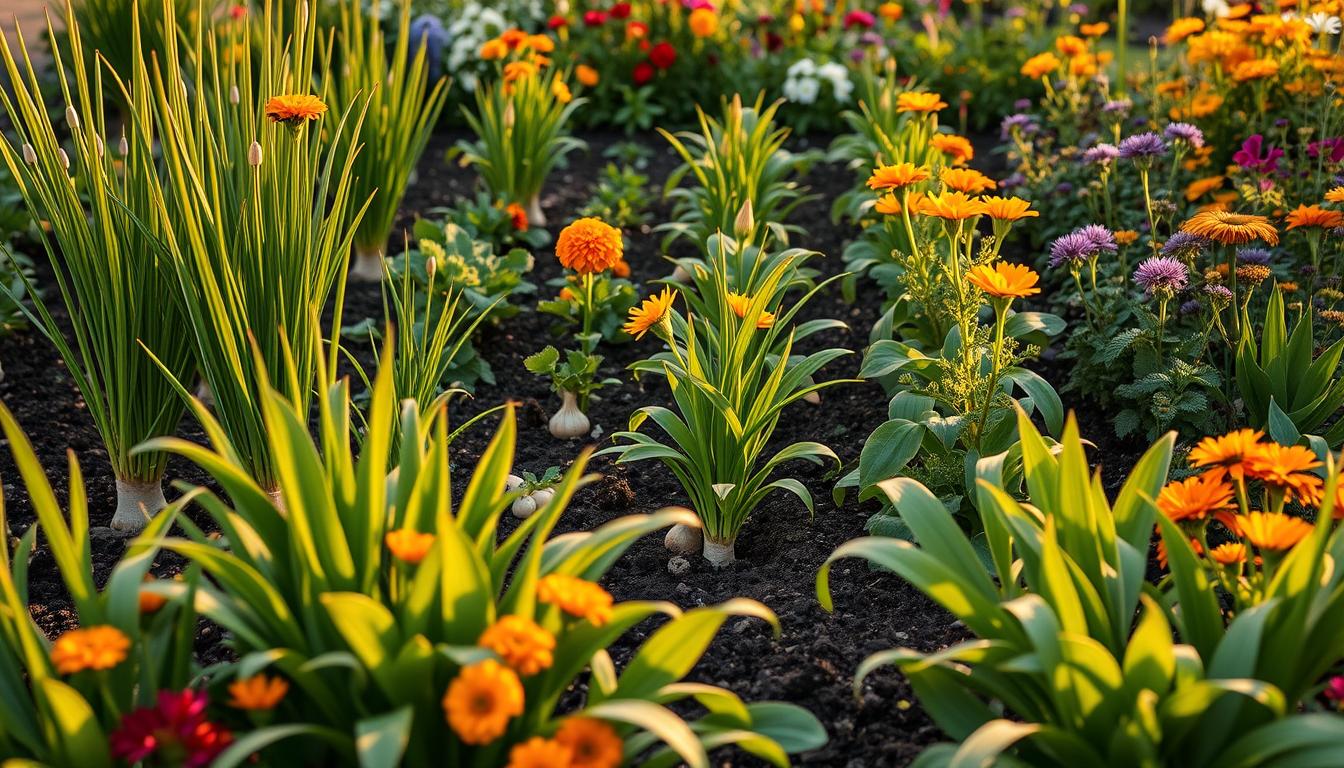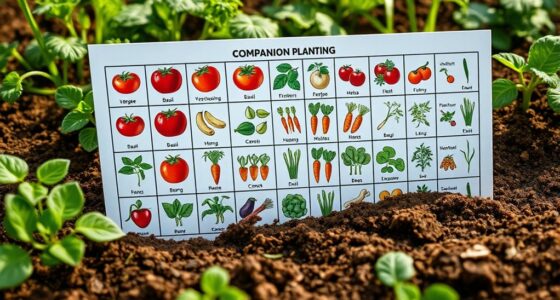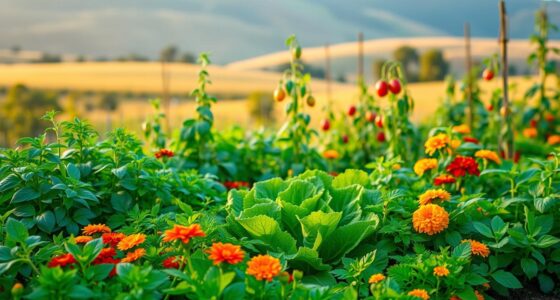Imagine walking through your garden, the warm sun on your face and the rich scent of soil surrounding you. As you admire your thriving plants, you notice how the vibrant greens and rich colors make the whole patch come alive. Among them, your onions stand tall, promising savory additions to countless meals. But did you know that neighboring plants can enhance their growth and flavor while also helping to keep pests at bay? Understanding onion companion plants is essential for any gardener looking to make the most of their harvest. In this article, we will explore the best companion plants for onions, providing you with onion planting tips that encourage a flourishing garden ecosystem.
Key Takeaways
- Companion planting boosts onion growth and health.
- Discover compatible vegetables, herbs, and flowers.
- Implement onion planting tips to maximize space.
- Learn how to create a thriving garden ecosystem.
- Utilize companion plants to improve soil health.
Why Companion Planting Matters in Your Garden
Companion planting with onions offers various benefits that enhance your gardening experience. By strategically placing certain plants together, you can create a thriving ecosystem in your garden. This practice leads to improved growth, flavor, pest control, and soil health, making it an essential technique for any gardener.
Enhancing Growth and Flavor
Plants grown together often support each other’s nutritional needs. Incorporating onion garden companions allows for an explosion of flavor in your culinary dishes while maximizing the growth potential of each plant. For instance, pairing onions with carrots can create a beneficial environment, where nutrients are shared, resulting in healthier and tastier vegetables.
Pest Control Benefits
Many organic onion companion plants serve as natural pest deterrents. The strong scent of onions helps to mask the aromas of neighboring plants, confusing and repelling pests. This strategic planting can significantly reduce the need for chemical pesticides, promoting a healthier garden ecosystem.
Improving Soil Health
Companion planting encourages a diverse range of plants, which contributes to improved soil health. This diversity can enhance soil structure and nutrient content, fostering a better environment for plant roots. Regularly incorporating organic onion companion plants not only enriches the soil but also supports overall garden vitality.
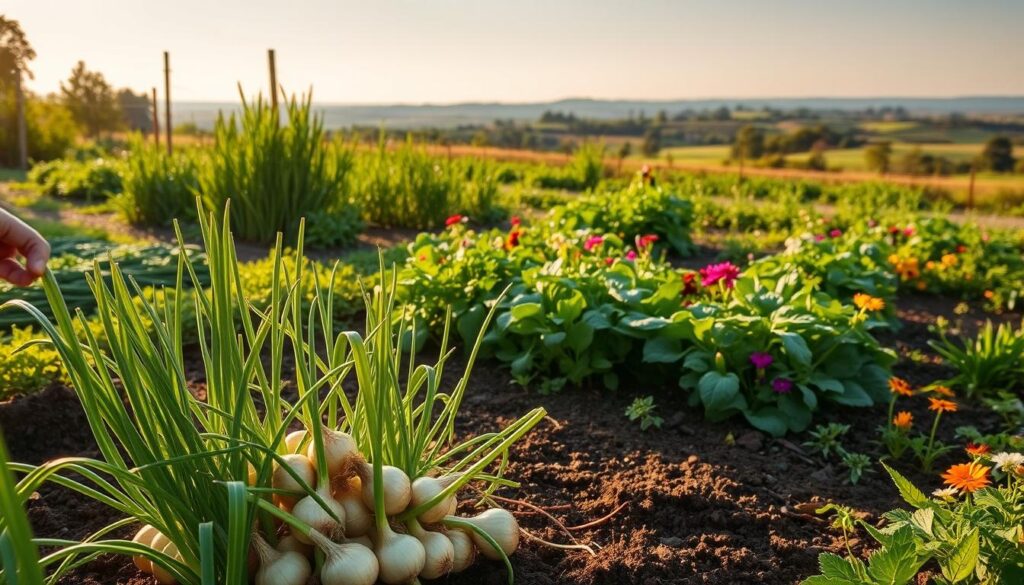
Best Companion Plants for Onions
Planting companions for onions can greatly enhance your garden’s productivity. With careful selection, you can create a thriving ecosystem that supports the growth of your onions while maximizing space. This onion companion planting guide will assist you in choosing the best companion plants for onions.
Carrots
Carrots are an excellent choice due to their differing root depths, which allows them to coexist with onions without competing for nutrients. Their unique scents can confuse pests, such as the onion fly, providing essential protection for your crop.
Beets
Beets thrive in similar conditions as onions, making them a compatible partner in your garden. They improve soil structure while offering nutrient benefits. Planting beets alongside onions not only helps in efficient space usage but also contributes to healthier soil.
Lettuce
Lettuce serves multiple purposes as a companion plant for onions. It acts as a cover crop, retaining soil moisture and minimizing weeds. This characteristic benefits the onions by providing a conducive environment for growth while allowing for a bountiful harvest of both crops.
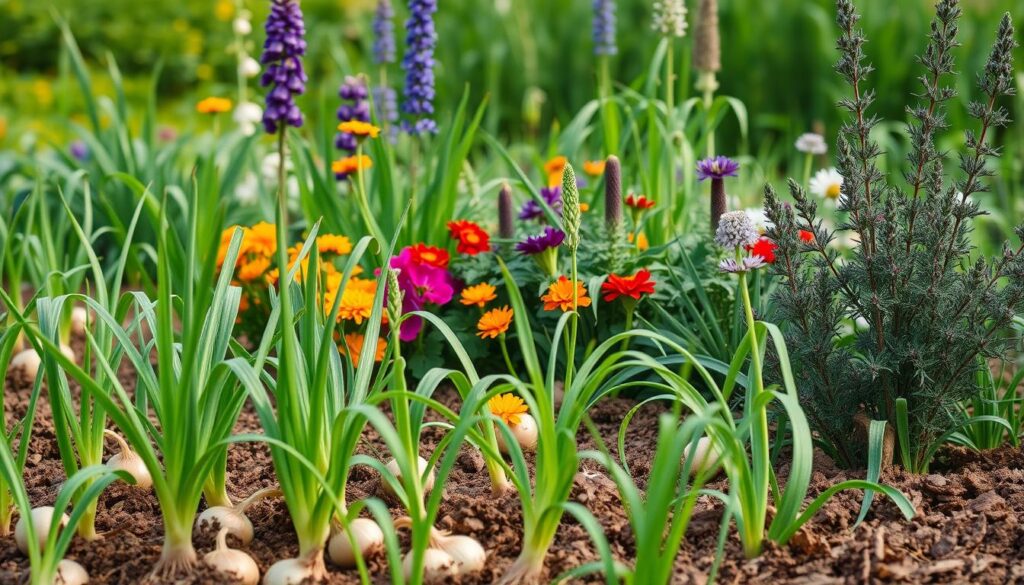
| Companion Plant | Benefits for Onions | Growth Depth |
|---|---|---|
| Carrots | Confuses pests like onion flies | Shallow |
| Beets | Improves soil structure | Medium |
| Lettuce | Retains moisture, reduces weeds | Shallow |
Herbs That Thrive Alongside Onions
Incorporating herbs into your garden can provide valuable benefits, particularly when paired with onions. These onion herb companions not only enhance the flavor of your dishes but also contribute to healthier plants. Certain herbs for companion planting can create a thriving ecosystem beneficial for both your herbs and onions.
Basil
Basil stands out among onion companion plants due to its pest-repelling qualities. The aromatic leaves not only complement onion flavor but significantly deter common pests like aphids and spider mites. This makes basil a delightful addition to your companion planting strategy.
Thyme
Thyme serves a dual purpose in the garden. As an onion herb companion, it acts as a living mulch that suppresses weed growth and helps retain moisture in the soil. This resilience makes thyme an excellent partner for onions, enhancing their growth environment while adding unique flavors to your culinary creations.
Oregano
Oregano is another useful herb that thrives when planted alongside onions. Its strong scent can confuse pests, offering an extra layer of protection against unwanted garden visitors. By including oregano in your herb patch, you benefit from its culinary uses while creating a favorable environment for your onion crops.
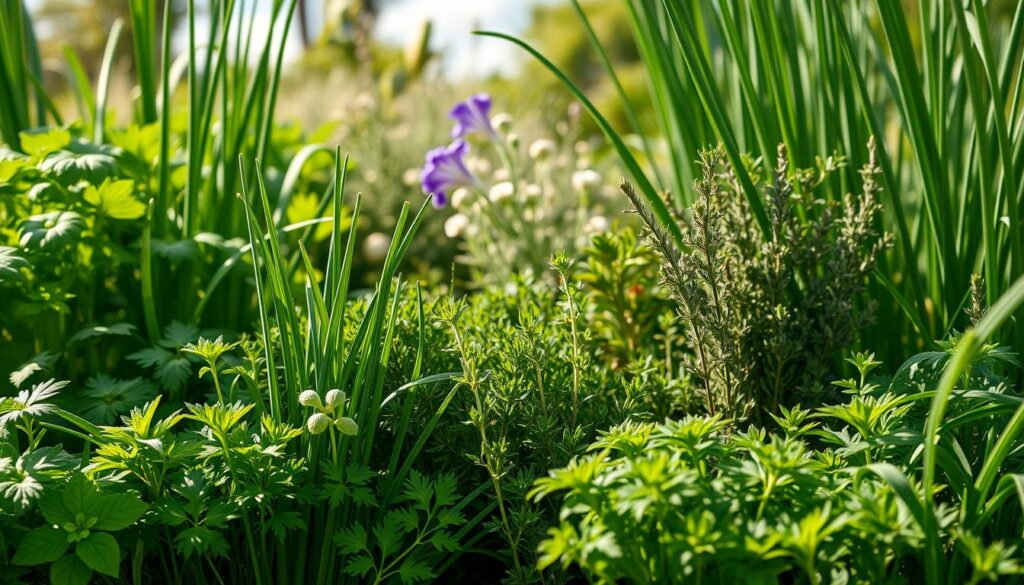
Flowers That Complement Onions in the Garden
When planning your vegetable garden, incorporating flowers can significantly enhance the health and beauty of your crops. Onion flowers companions play a vital role in creating a thriving ecosystem for your onion plants. Certain flowers not only protect your onions from pests but also attract beneficial insects essential for pollination and natural pest control.

Marigolds
Marigolds stand out among companion plants for onions in the vegetable garden due to their pest-repelling qualities. The strong scent emitted by these vibrant flowers helps deter unwelcome guests like onion flies and aphids. Their striking blooms can also add a splash of color to your garden, making it visually appealing.
Nasturtiums
Nasturtiums present another excellent choice among beneficial flowers. They attract beneficial insects such as ladybugs and lacewings, which help manage pest populations. Furthermore, they have the added benefit of repelling harmful pests like aphids, contributing to a healthier environment for your onion crop.
Incorporating these flowers into your garden not only enhances its aesthetic appeal but also promotes a more robust and thriving vegetable garden. By selecting the right onion flowers companions, you take a significant step toward ensuring the success of your onion plants.
Vegetables That Pair Well with Onions
When planning your garden, incorporating the right vegetables that pair with onions can significantly enhance your harvest. Certain companions not only thrive alongside onions but also help in deterring pests and providing a robust growing environment.
Cabbage
Cabbage stands out as an excellent choice among onion vegetable companions. Its growth is often complemented by onions, which repel common pests like cabbage worms. By planting these together, you create a harmonious ecosystem in your garden.
Brussels Sprouts
Brussels sprouts share similar beneficial attributes. Much like cabbage, they flourish well when paired with onions. This combination supports healthier growth as onions protect Brussels sprouts from pests that could otherwise hinder their development.
Peas
Peas can also make a great addition to your garden alongside onions. Though it’s vital to assess nutrient requirements, these two can coexist effectively. Following some onion companion planting tips, you can ensure that both thrive, enriching your garden’s biodiversity.
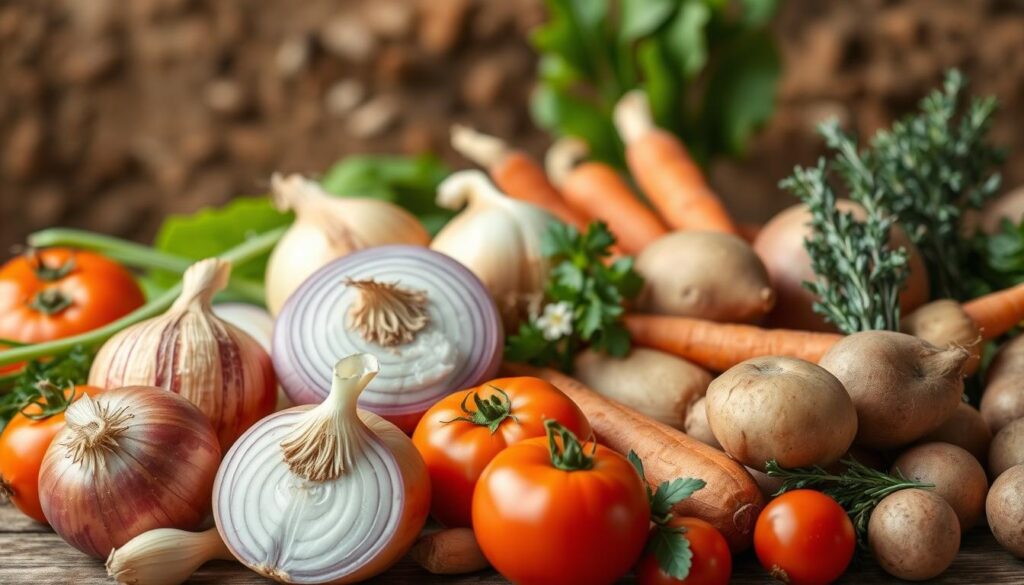
Plants to Avoid Near Onions
When planning your onion garden, it is essential to be aware of incompatible companion plants. Planting certain varieties too close to your onions can create various challenges, including nutrient competition and increased pest attraction. Below are some key plants to avoid with onions to ensure a healthier garden.
Legumes
Legumes, such as beans and peas, are poor companions for onions. They compete for nutrients in the soil, which can lead to stunted growth and reduced yields. The nitrogen-fixing qualities of legumes can also negatively impact the flavor of onions.
Potatoes
Potatoes are notorious for their soil requirements, which often conflict with those of onions. This can lead to moisture and nutrient competition, resulting in poor growth for both species. Avoid planting these two together to minimize onion garden challenges.
Other Alliums
Garlic, leeks, and other alliums belong to the same family as onions. Planting these incompatible companion plants together can heighten susceptibility to pests and diseases, affecting the health of your onion crop. Steering clear of other alliums can be key to maintaining an effective garden.
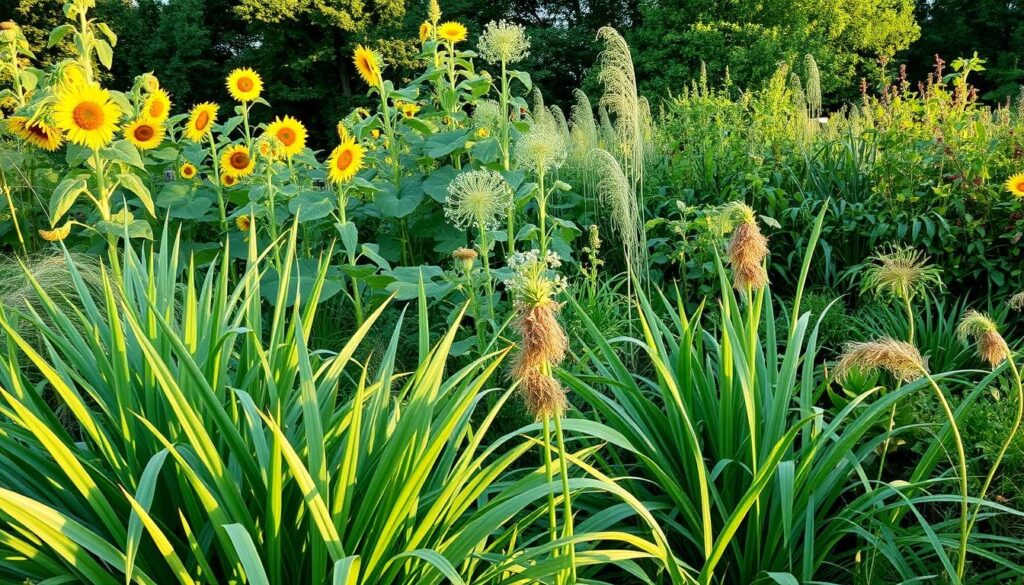
| Plant Type | Reason to Avoid |
|---|---|
| Legumes | Compete for nutrients |
| Potatoes | Conflicts in soil requirements |
| Other Alliums | Heightened pest susceptibility |
How Planting Companions Can Boost Onion Yield
Companion planting offers significant benefits for onions, particularly in terms of onion yield improvement. By understanding how to maximize garden space effectively, you can grow various crops together, resulting in healthier onion harvests. The key lies in the unique growth relationships among different plants.
Maximizing Space
Utilizing companion plants allows you to maximize garden space efficiently. When you interplant onions with companions that grow differently in height or root depth, you create a dynamic growing environment. This strategy not only conserves space but also enhances productivity. Workers in the field often note the benefits of strategically placing quick-growing plants alongside slower ones, allowing for more efficient use of the soil.
Crop Rotation Advantages
Engaging in crop rotation with onions plays a vital role in maintaining soil health. By alternating onions with compatible plants, you can help reintroduce essential nutrients into the soil. This practice reduces the risk of disease and pest infestations, ensuring that your onion plants thrive year after year. Observing the effects of crop rotation can often lead to noticeable improvements in onion growth and yield.

Tips for Successful Companion Planting
Successful companion planting for onions relies on several strategies that enhance growth and yield. You will want to focus on choosing compatible plants for onions that share similar growing conditions. A well-planned onion planting layout can boost your garden’s productivity and health. These tips will guide you in creating a thriving garden.
Choosing Compatible Plants
When selecting companion plants for onions, aim for those that will not compete for nutrients. Carrots and beets are excellent choices, as they thrive alongside onions without hindering their growth. Consider the specific needs of each plant species to ensure they complement rather than crowd each other. Observing their growth habits will further enhance your successful companion planting strategy.
Planting Layout and Design
Creating an effective onion planting layout is essential for maximizing space and promoting healthy growth. Arrange your plants in a way that allows sufficient light and air circulation. Utilize vertical space where possible and group plants with similar water and nutrient requirements. Incorporating companion plants like marigolds can enhance onion health while adding visual appeal to your garden design.
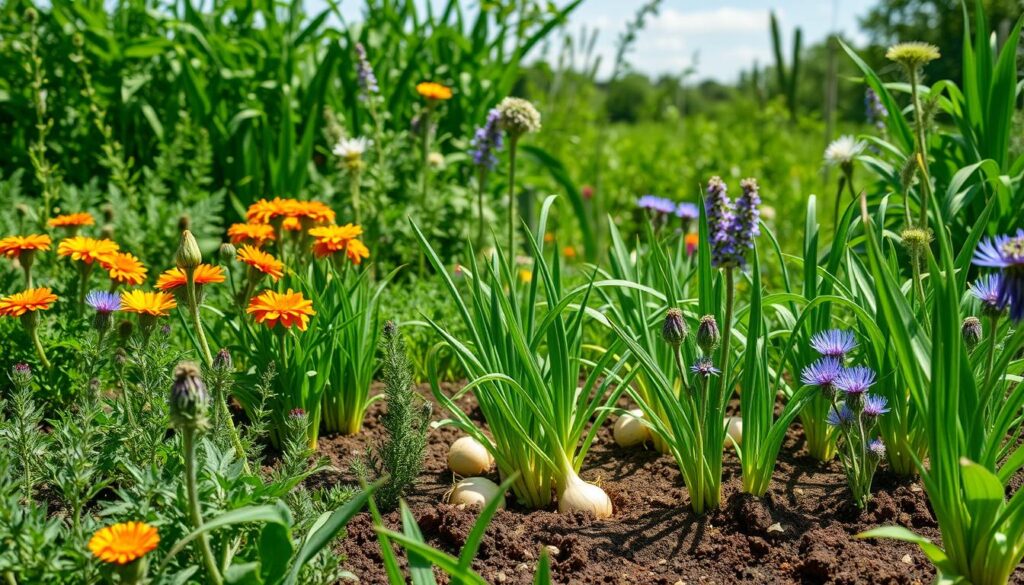
Seasonal Considerations for Onions and Companions
Understanding seasonal planting for onions is essential for maximizing your harvest. Timing your onion companion planting can lead to thriving plants and a more productive garden. Both spring and fall gardening present unique opportunities to pair onions with compatible plants, creating an ecosystem that benefits all crops.
Spring Planting Strategies
Spring offers an optimal opportunity to plant onions along with rapid-growing companions. Sowing quick-maturing crops like lettuce and radishes allows for early harvesting, making space for the onions to flourish later in the season. Pairing these vegetables is an effective strategy to take advantage of available space and sunlight. When planning your spring gardening, consider the following:
| Companion Plant | Benefit | Time to Harvest |
|---|---|---|
| Lettuce | Early harvest frees up space for onions | 30-60 days |
| Radishes | Quick-growing, helps break up soil | 25-30 days |
| Carrots | Deep roots, helps aerate soil | 70-80 days |
Fall Companion Planting
Fall gardens benefit from companion planting with hardy vegetables and herbs. Opt for plants that can overwinter and continue to thrive alongside your onions. This method not only extends your gardening season but also leverages the pest-repelling properties of onions. Recommended fall companions include:
- Garlic – enhances onion’s pest resistance
- Kale – withstands cold weather and provides nutrients
- Spinach – grows well alongside onions and can be harvested in early spring

Companion Planting for Organic Gardening
Embracing organic gardening through companion planting offers numerous rewards, including enhanced pest management and improved plant health. Utilizing natural pest deterrents allows you to keep harmful insects at bay without resorting to chemicals, making this method an integral part of sustainable gardening. With organic onion companion plants, the benefits stretch beyond mere aesthetics, promoting a vibrant ecosystem where all plants thrive together.
Utilizing Natural Pest Deterrents
Incorporating companion plants known for their pest-repelling properties can greatly enhance your organic garden’s defenses. For example, marigolds are famed for warding off nematodes, while aromatic herbs can deter various garden pests. You not only protect your onions but also create a harmonious environment where all plants can flourish. This strategy emphasizes the organic gardening benefits that come from completely natural solutions.
Enhancing Biodiversity
Creating a diverse garden with various companion plants boosts biodiversity and strengthens your garden ecosystem. This variety encourages beneficial insects, which help pollinate and control pests. By choosing a mix of compatible plants, you foster a resilient environment that can adapt to changing conditions. Implementing this practice enriches sustainable gardening, leading to healthier crops and superior yields.
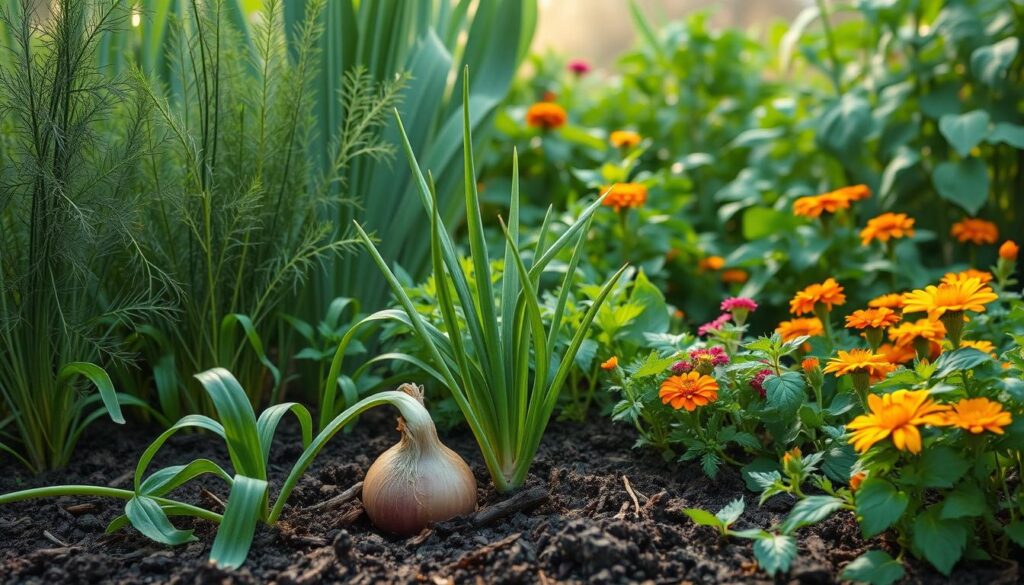
Common Mistakes in Companion Planting
As you embark on your gardening journey, avoiding common companion planting pitfalls is essential for a successful harvest. Many gardeners, especially those new to onion gardening, often overlook crucial details that can impact plant health and yield. Recognizing these onion gardening mistakes will help you achieve effective garden planning and create a thriving environment for your crops.
Ignoring Plant Growth Requirements
One of the most significant mistakes in companion planting is ignoring the specific growth requirements of each plant. Each species has unique needs regarding sunlight, water, and nutrients. If these requirements are not met, you may witness stunted growth and lower yields. Prioritize understanding the needs of your onions and their companions to prevent any adverse effects on growth.
Not Considering Plant Heights
Another common error involves the arrangement of plants based on their heights. Taller plants can easily overshadow shorter ones, depriving them of vital sunlight. This shading can lead to competition for resources, ultimately resulting in weakened plants. Thoughtful placement can enhance the effectiveness of your garden layout, allowing every plant to thrive.
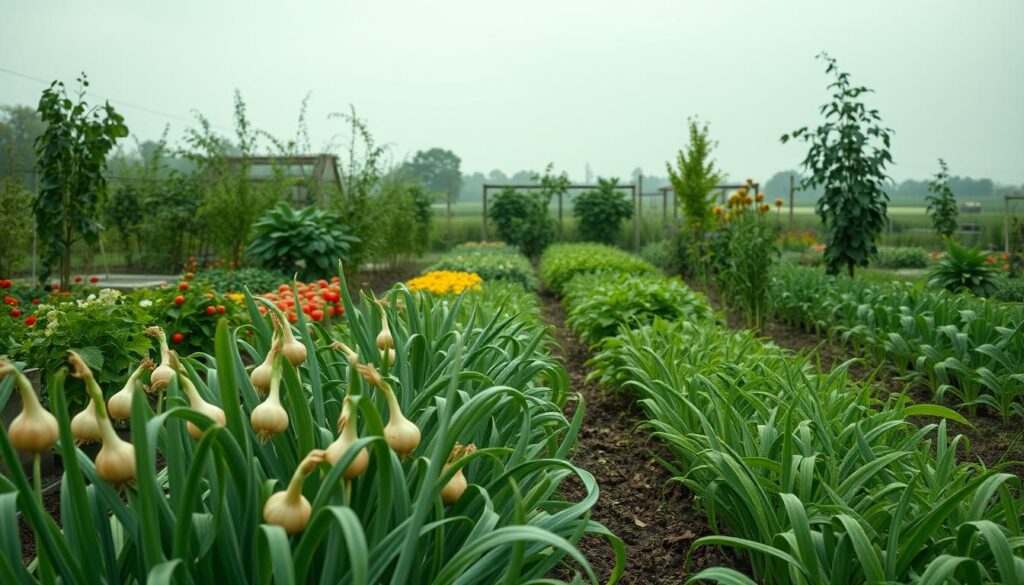
The Role of Companion Planting in Food Security
Companion planting significantly contributes to food security by fostering stronger local ecosystems and encouraging diversity in your garden. By planting compatible crops together, you enhance the interplay of plants, which can lead to improved yields. This practice not only supports sustainable gardening practices but also highlights the ecological gardening benefits that come from creating a symbiotic environment.
Supporting Local Ecosystems
When you engage in companion planting, you create a microhabitat that nurtures beneficial insects, pollinators, and soil organisms. This approach strengthens the resilience of local ecosystems, making them more capable of withstanding pests and diseases. As you incorporate more varieties of plants, you boost biodiversity and actively participate in a healthier environment.
Reducing Dependency on Chemical Inputs
By utilizing companion planting techniques, you can reduce the need for chemical fertilizers and pest control measures. Natural partnerships between plants enable them to thrive without synthetic enhancements. This leads to cleaner produce and promotes a healthier ecosystem in your garden. Implementing these sustainable gardening practices is a step towards a more self-sufficient food system.

How to Plan Your Onion Companion Garden
Planning an onion garden requires careful consideration of various factors that contribute to a successful yield. An effective companion planting garden layout can enhance the growth of your onions and their neighboring plants. Understanding the optimal spacing and timing for planting will help you create a thriving garden.
Garden Layout Essentials
A well-thought-out garden layout is essential for maximizing space and promoting healthy growth. Choose a spot that provides ample sunlight for your onions and their companions. Create rows or clusters that allow for sufficient air circulation, which helps prevent diseases. When planning an onion garden, consider height and spread to prevent taller plants from shading shorter ones. Incorporating companion plants strategically can also deter pests and improve overall plant health.
Timing and Spacing
Timing is critical for successful onion planting. Ensure you align your planting schedule with the seasonal preferences of both onions and their companions. Start onions indoors or outdoors based on your climate. Maintaining appropriate spacing between each plant is crucial to avoid competition for nutrients and water. Following these onion planting tips can lead to a bumper harvest, making your efforts in companion planting truly worthwhile.
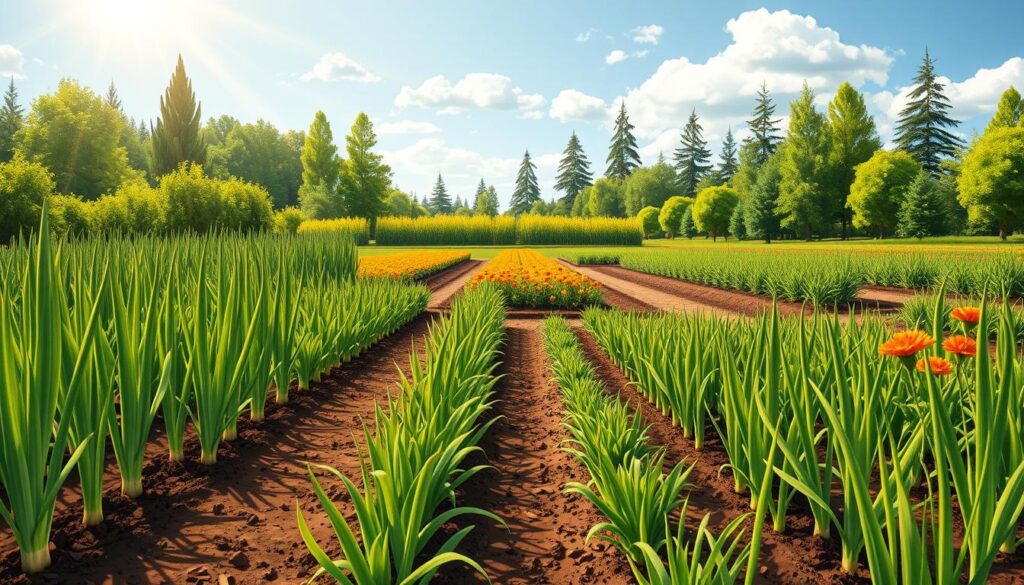
Harvesting and Maintaining Your Companion Crops
Ensuring a successful garden involves knowing the right moments for harvesting onions and their companion plants, as well as strategies for maintaining vegetable garden health. Monitoring your garden’s status can vastly improve the quality and yield of your crops. With proper practices, you can elevate your onion crop care and maximize flavors in the kitchen.
When to Harvest Onions and Companions
Onions typically indicate they’re ready for harvesting through several signs. Look for yellowing tops and swelling bulbs, which suggest maturity. Depending on the variety, this process may vary. Keeping a close eye on your onions is essential for choosing the optimal time for harvesting onions without compromising their quality. Alongside onions, monitor the readiness of companion plants like carrots and lettuce, which often mature around the same time, allowing for a synchronized harvest.
Tips for Maintaining Garden Health
Maintaining vegetable garden health plays a crucial role in the overall success of your gardening efforts. Regular inspection for pests and diseases can help you catch issues early, preventing them from spreading. Additionally, focus on managing soil moisture levels effectively. Over-watering can lead to root rot, while under-watering stresses plants. Providing adequate nutrients through organic fertilizers promotes healthy growth in all your crops. Consistent attention in these areas fosters strong onion crop care and vibrant companion plants.

Success Stories: Home Gardeners and Companion Plants
Many home gardeners have ventured into the world of companion planting, discovering remarkable results with their onion crops. Through shared gardening success stories, you can find inspiration in what others have achieved using strategic combinations of plants. These accounts highlight how thoughtful planting not only boosts yields but also enhances flavors in the garden.
Case Studies of Successful Gardens
In various community gardening initiatives, companions such as carrots and marigolds have proven effective alongside onions. One notable case study features a community garden that integrated diverse companion plants. This approach resulted in richer soil and bountiful harvests. The gardeners reported stronger onion plants and increased resilience against pests. Each case serves as a testament to the potential of thoughtful companion planting experiences.
Testimonials from Enthusiastic Gardeners
Enthusiastic gardeners frequently share their positive companion planting experiences through local gardening clubs and forums. One gardener noted how adding basil to her onion plot not only improved plant health but also enhanced the flavor of the onions. Another reported that incorporating nasturtiums created a dazzling display while repelling harmful insects. Such testimonials encourage many to explore similar techniques in their community gardening efforts.

Resources for Further Learning on Companion Planting
As you venture deeper into the world of companion planting, you’ll find a wealth of resources to guide your learning journey. Books and gardening guides can provide detailed information on various plant pairings and their benefits, enhancing your understanding of how to cultivate a thriving garden. Comprehensive texts, such as “The Vegetable Gardener’s Bible” by Edward C. Smith, offer practical advice on maximizing garden potential through thoughtful plant companions.
In addition to traditional literature, online gardening communities and forums are excellent avenues for exchanging knowledge. Participating in these platforms allows you to connect with fellow gardeners who share their experiences and insights. Websites like Reddit’s r/gardening or various Facebook groups dedicated to gardening can be treasure troves of information, tips, and discussions around effective companion planting strategies.
By engaging with diverse companion planting resources, including both gardening guides and online communities, you can refine your gardening skills and create more productive growing spaces. Expanding your resources will not only enhance your knowledge but also foster a supportive network as you share your own gardening trials and triumphs.
